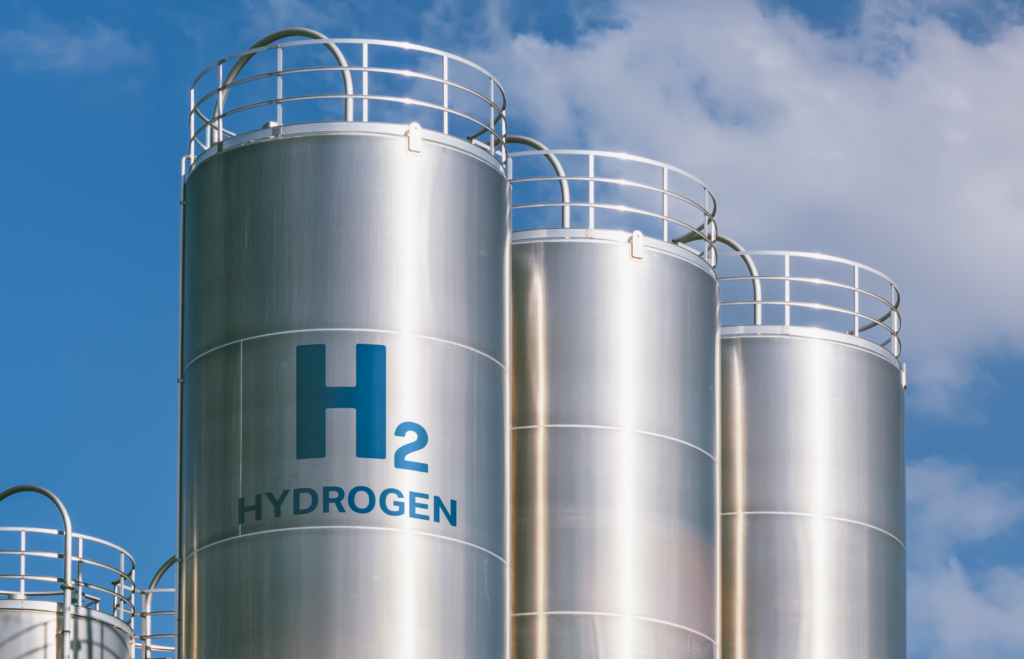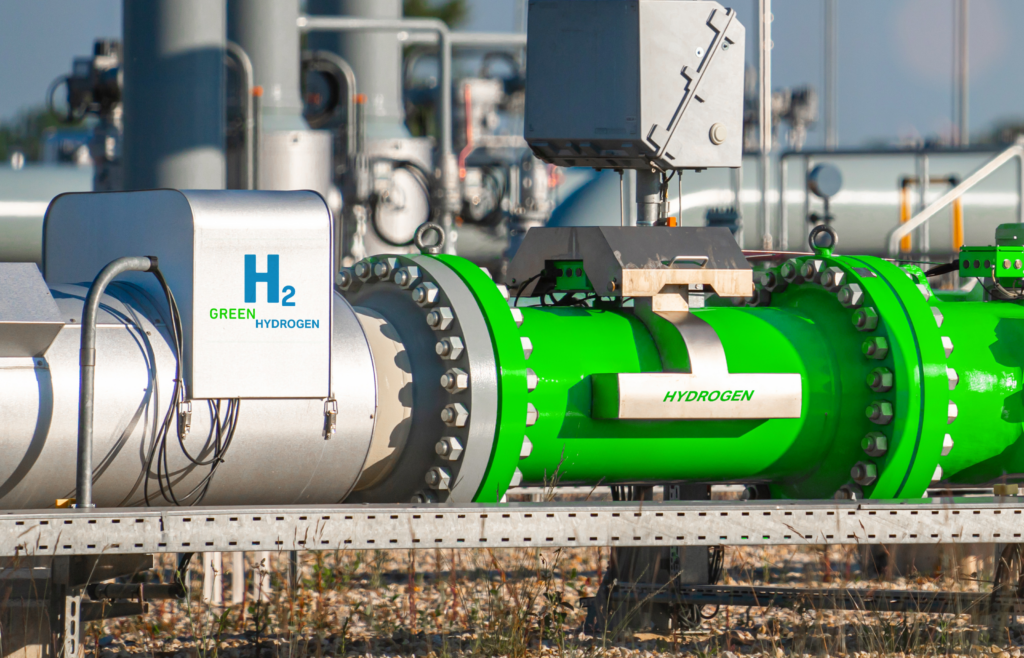The Basics: What is Hydrogen?
Hydrogen (H2) is an extraordinary element characterized by exceptional properties. It is lighter than air and more abundant than carbon. Perhaps most importantly, when burned, Hydrogen yields only water vapor as its exhaust. Because of these and many other factors, Hydrogen is increasingly emerging as a prominent contender in the quest to decarbonize electricity generation and transportation on a global scale. Companies are intensifying their endeavors to scale up hydrogen production, driven by government incentives and mounting environmental imperatives. While hydrogen currently presents certain handling challenges, its allure as a pristine and sustainable fuel source is indisputably compelling.
Hydrogen Comes in Many “Colors”
Hydrogen is classified into several categories, each bearing its unique color code. These designations include green, blue, brown, and even unconventional variations like yellow, turquoise, and pink. These color codes serve as practical indicators, facilitating the distinction between various hydrogen sources and production techniques.
It is critical to understand that these color-coded distinctions lack universal standardization. Instead, they remain dynamic, evolving over time and demonstrating variations from one geographical region or nation to another. Therefore, stakeholders involved in the hydrogen sector must remain abreast of evolving terminology and regional disparities to ensure they can navigate the industry effectively.
Green Hydrogen
“Green” Hydrogen is produced through the electrolysis of water, using zero-carbon electricity. It is the most environmentally friendly, as it generates no carbon emissions during production. Currently, only around 4% of the world’s hydrogen would be classified as “green hydrogen.”
Black and Brown Hydrogen
“Black” Hydrogen and “Brown” Hydrogen are produced from coal in a highly carbon-intensive process. While these have historically been a large source of hydrogen, their environmental impact is quite significant, contributing greatly to greenhouse gas emissions.
Gray Hydrogen
“Gray” Hydrogen is primarily derived from methane, often through a process called steam methane reforming (“SMR”). Although it is a widely used method, it also produces substantial carbon emissions.
Blue Hydrogen
“Blue” Hydrogen is generated from fossil fuels and incorporates carbon capture and storage (“CCS”) technology to capture and permanently store the majority of CO2 emissions underground. Blue hydrogen strikes a balance between conventional and green hydrogen production methods.
Pink Hydrogen
“Pink” hydrogen is generated through electrolysis powered by nuclear energy. Nuclear-produced hydrogen can also be referred to as “purple” hydrogen or even “red” hydrogen. In addition, the very high temperatures from nuclear reactors could be used in other hydrogen productions by producing steam for more efficient electrolysis or fossil gas-based steam methane reforming.
Turquoise Hydrogen
“Turquoise” Hydrogen is a new entry in the hydrogen color charts and production has yet to be proven at scale. It is made using a process called methane pyrolysis to produce hydrogen and solid carbon. In the future, this method may be valued as low-emission hydrogen, dependent on the thermal process being powered with renewable energy and the carbon being permanently stored or used.
Yellow Hydrogen
“Yellow” hydrogen is a relatively new phrase for hydrogen made through electrolysis using solar power.
White Hydrogen
“White” hydrogen is a naturally occurring, geological hydrogen found in underground deposits and created through fracking. There are currently no strategies to exploit this hydrogen on a mass scale.
The Differences
The hydrogen pathways associated with the highest carbon intensity and darkest color codes rely on fossil fuel energy sources, yielding carbon dioxide (CO2) and carbon monoxide (CO) as undesirable byproducts. Specifically, black, brown, and grey hydrogen are generated through thermochemical processes that involve the decomposition of coal or natural gas. The resulting CO2 and CO emissions are typically vented directly into the atmosphere, contributing to greenhouse gas emissions.
Approximately 95 percent of hydrogen production in the United States falls under carbon-intensive categories (black, brown, or gray). This significant reliance on such methods contributes to hydrogen production being responsible for 2.2 percent of global emissions, underscoring the need for cleaner and more sustainable hydrogen production technologies.
How Can Hydrogen Help Reduce GHG Emissions?
Blue and turquoise hydrogen represent innovative approaches for utilizing natural gas as a feedstock while minimizing carbon dioxide emissions. Blue hydrogen is produced through a process akin to grey hydrogen, with the added step of capturing and securely storing the CO2 byproducts. These technologies, often grouped under the umbrella of carbon capture, utilization, and sequestration (CCUS), are presently in the early stages of development, with challenges in achieving high capture rates and cost-effectiveness. Nevertheless, they hold the potential to become crucial tools for decarbonization if technological advancements and efforts to reduce upstream emissions progress significantly.
In contrast, turquoise hydrogen also relies on natural gas as a feedstock but offers a unique advantage. Instead of producing carbon dioxide, it generates solid carbon as a byproduct. This solid carbon can be either disposed of safely or repurposed for various applications, including the creation of plastics, construction materials, or tires, adding an intriguing dimension to the potential sustainability of hydrogen production.
The Green Hydrogen Boom
The emergence of green hydrogen represents a significant boom in the quest for sustainable energy solutions. It stands out as an environmentally superior alternative to other hydrogen varieties, primarily owing to its sustainable production methods. Green hydrogen is manufactured using renewable energy sources, resulting in zero carbon emissions throughout the process. This minimal environmental impact contributes to the reduction of air pollution and alleviates the detrimental consequences often associated with fossil fuel extraction and combustion.
Furthermore, green hydrogen serves as a valuable energy storage solution, allowing surplus electricity generated from intermittent renewables like wind and solar to be efficiently stored as hydrogen for future utilization. Its versatility is a key asset, finding application across a wide spectrum of sectors, including transportation, industrial processes, power generation, and heating. This versatility, in turn, contributes to a decreased reliance on fossil fuels and a more sustainable energy landscape.
However, it is essential to acknowledge that, at present, the production and infrastructure development of green hydrogen may be more costly and less widespread when compared to other hydrogen production methods. Nevertheless, ongoing technological advancements and increased investments in green hydrogen are poised to address these challenges, ultimately rendering it a more accessible and economically viable energy source in the foreseeable future.
Future of Green Hydrogen
It certainly appears that the future of energy and sustainability hinges on our ability to harness the power of hydrogen effectively. As green hydrogen gains traction and the hydrogen industry continues to expand, it is essential to recognize the importance of clean and sustainable hydrogen production. With the guidance of hydrogen experts, we can navigate the complexities of this burgeoning field and work towards a greener, hydrogen-powered future. The hydrogen boom is here, and it holds the promise of a more sustainable and environmentally friendly world.
Partner with LEC for Green Hydrogen Success
At LEC Partners, we are dedicated to helping businesses of all sizes achieve sustainable and successful outcomes. Whether you’re a startup or a multinational company, our community of world-renowned bioeconomy experts has the experience and expertise to guide you to success.
Why Choose LEC Partners?
- Unmatched Bioeconomy Expertise: As trusted leaders in the bioeconomy, we deliver sustainable and profitable results, guiding projects from planning to execution.
- Customized Teams: Your project is unique, and so is our approach. We assemble a custom team to meet your specific needs, whether you require one expert or many.
- Streamlined Communication: No matter the size of your project team, you will always have a single point of contact for seamless coordination and communication.
- Comprehensive Services: Beyond engineering, operational, and financial guidance, we offer additional services like regulatory support and expert witness testimony, to ensure you are covered from every angle.
Ready to Transform Your Green Hydrogen Business?
Take the next step and partner with us to shape the future of Green Hydrogen. Contact us today to learn how our community of over 180 bioeconomy experts can help you achieve your goals.

